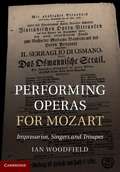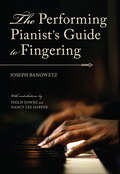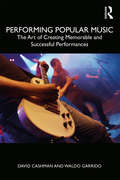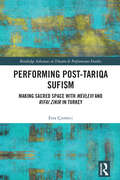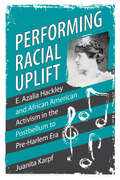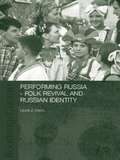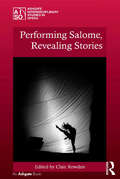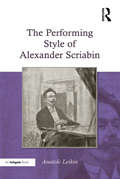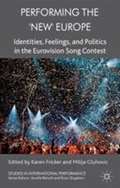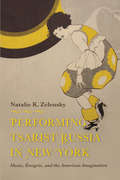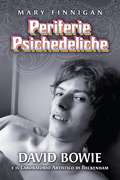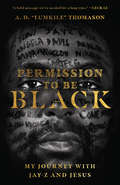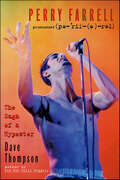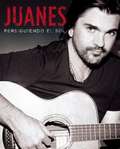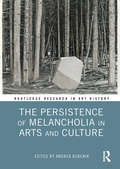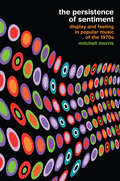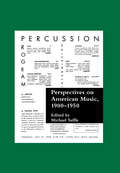- Table View
- List View
Performing Operas for Mozart: Impresarios, Singers and Troupes
by Ian WoodfieldThe Italian opera company in Prague managed by Pasquale Bondini and Domenico Guardasoni played a central role in promoting Mozart's operas during the final years of his life. Using a wide range of primary sources which include the superb collections of eighteenth-century opera posters and concert programmes in Leipzig and the Indice de' teatrali spettacoli, an almanac of Italian singers and dancers, this study examines the annual schedules, recruitment networks, casting policies and repertoire selections of this important company. Woodfield shows how Italian-language performances of Figaro, Don Giovanni, Così fan tutte and La clemenza di Tito flourished along the well-known cultural axis linking Prague in Bohemia to Dresden and Leipzig in Saxony. The important part played by concert performances of operatic arias in the early reception of Mozart's works is also discussed and new information is presented about the reception of Josepha Duschek and Mozart in Leipzig.
Performing Operas for Mozart
by Ian WoodfieldThe Italian opera company in Prague managed by Pasquale Bondini and Domenico Guardasoni played a central role in promoting Mozart's operas during the final years of his life. Using a wide range of primary sources which include the superb collections of eighteenth-century opera posters and concert programmes in Leipzig and the Indice de' teatrali spettacoli, an almanac of Italian singers and dancers, this study examines the annual schedules, recruitment networks, casting policies and repertoire selections of this important company. Woodfield shows how Italian-language performances of Figaro, Don Giovanni, Cosi fan tutte and La clemenza di Tito flourished along the well-known cultural axis linking Prague in Bohemia to Dresden and Leipzig in Saxony. The important part played by concert performances of operatic arias in the early reception of Mozart's works is also discussed and new information is presented about the reception of Josepha Duschek and Mozart in Leipzig.
The Performing Pianist's Guide to Fingering
by Joseph BanowetzThe Performing Pianist's Guide to Fingering, the much-anticipated companion to Joseph Banowetz's The Pianist's Guide to Pedaling, provides practical fingering solutions for technical musical passages. Banowetz contends that fingering choices require much thought and consideration and that too often these choices are influenced by historical traditions and ideas rather than by actual performance conditions. By returning to the unedited original compositions, he strives to help the advanced pianist think through the composer's musical intent and the actual performance tempo and dynamics when selecting the fingering. Banowetz also includes valuable contributions by Philip Fowke, who examines redistributions by Benno Moiseiwitsch in Rachmaninoff's compositions, and Nancy Lee Harper, who explores the often very different approaches to fingering found in keyboard music of the Baroque era. The Performing Pianist's Guide to Fingering will be useful to the advanced pianist and to instructors looking to guide students in improving this important art.
Performing Popular Music: The Art of Creating Memorable and Successful Performances
by David Cashman Waldo GarridoThis book explores the fundamentals of popular music performance for students in contemporary music institutions. Drawing on the insights of performance practice research, it discusses the unwritten rules of performances in popular music, what it takes to create a memorable performance, and live popular music as a creative industry. The authors offer a practical overview of topics ranging from rehearsals to stagecraft, and what to do when things go wrong. Chapters on promotion, recordings, and the music industry place performance in the context of building a career. Performing Popular Music introduces aspiring musicians to the elements of crafting compelling performances and succeeding in the world of today’s popular music.
Performing Post-Tariqa Sufism: Making Sacred Space with Mevlevi and Rifai Zikir in Turkey (Routledge Advances in Theatre & Performance Studies)
by Esra ÇizmeciThis ethnographic research project examines the generation of post-tariqa Tasavvuf (Sufism: a spiritual practice and philosophy recognised as the inner dimension of Islam) in a variety of private, semi-public, public, secular and sacred urban spaces in present-day Turkey. Through extensive field research in minority Sufi communities, this book investigates how devotees of specific orders maintain, adapt, mobilise, and empower their beliefs and values through embodied acts of their Sufi followers. Using an ethnographic methodology and theories derived from performance studies, Esra Çizmeci examines the multiple ways in which the post-tariqa Mevlevi and Rifai practice is formed in present-day Turkey, such as through the authority of the spiritual teacher; the individual and collective performance of Sufi rituals; nefs (self) training; and, most importantly, the practice of Sufi doctrines in everyday life through the production of sacred spaces. Drawing on the theories of performance, she examines how the Sufi way of living and spaces are created anew in the process of each devotee’s embodied action. This book is informed by theories in performance studies, anthropology, religious studies, and cultural studies and places current Sufi practices in a historical perspective.
Performing Racial Uplift: E. Azalia Hackley and African American Activism in the Postbellum to Pre-Harlem Era (Margaret Walker Alexander Series in African American Studies)
by Juanita Karpf2023 CHOICE Outstanding Academic TitleIn Performing Racial Uplift: E. Azalia Hackley and African American Activism in the Postbellum to Pre-Harlem Era, Juanita Karpf rediscovers the career of Black activist E. Azalia Hackley (1867–1922), a concert artist, nationally famous music teacher, and charismatic lecturer. Growing up in Black Detroit, she began touring as a pianist and soprano soloist while only in her teens. By the late 1910s, she had toured coast-to-coast, earning glowing reviews. Her concert repertoire consisted of an innovative blend of spirituals, popular ballads, virtuosic showstoppers, and classical pieces. She also taught music while on tour and visited several hundred Black schools, churches, and communities during her career. She traveled overseas and, in London and Paris, studied singing with William Shakespeare and Jean de Reszke—two of the classical music world’s most renowned teachers. Her acceptance into these famous studios confirmed her extraordinary musicianship, a “first” for an African American singer. She founded the Normal Vocal Institute in Chicago, the first music school founded by a Black performer to offer teacher training to aspiring African American musicians. Hackley’s activist philosophy was unique. Unlike most activists of her era, she did not align herself unequivocally with either Booker T. Washington or W. E. B. Du Bois. Instead, she created her own mediatory philosophical approach. To carry out her agenda, she harnessed such strategies as giving music lessons to large audiences and delivering lectures on the ecumenical religious movement known as New Thought. In this book, Karpf reclaims Hackley's legacy and details the talent, energy, determination, and unprecedented worldview she brought to the cause of racial uplift.
Performing Rites: On the Value of Popular Music
by Simon FrithWho's better? Billie Holiday or P. J. Harvey? Blur or Oasis? Dylan or Keats? And how many friendships have ridden on the answer? Such questions aren't merely the stuff of fanzines and idle talk; they inform our most passionate arguments, distill our most deeply held values, make meaning of our ever-changing culture. In Performing Rites, one of the most influential writers on popular music asks what we talk about when we talk about music. What's good, what's bad? What's high, what's low? Why do such distinctions matter? Instead of dismissing emotional response and personal taste as inaccessible to the academic critic, Simon Frith takes these forms of engagement as his subject--and discloses their place at the very center of the aesthetics that structure our culture and color our lives. Taking up hundreds of songs and writers, Frith insists on acts of evaluation of popular music as music. Ranging through and beyond the twentieth century, Performing Rites puts the Pet Shop Boys and Puccini, rhythm and lyric, voice and technology, into a dialogue about the undeniable impact of popular aesthetics on our lives. How we nod our heads or tap our feet, grin or grimace or flip the dial; how we determine what's sublime and what's "for real"--these are part of the way we construct our social identities, and an essential response to the performance of all music. Frith argues that listening itself is a performance, both social gesture and bodily response. From how they are made to how they are received, popular songs appear here as not only meriting aesthetic judgments but also demanding them, and shaping our understanding of what all music means.
Performing Rites: On the Value of Popular Music
by Simon FrithAn influential writer on popular music asks what we talk about when we talk about music. Instead of dismissing emotional response and personal taste as inaccessible to academic critics, Frith takes these forms of engagement as his subject—and discloses their place at the center of the aesthetics that structure our culture and color our lives.
Performing Russia: Folk Revival and Russian Identity (BASEES/Routledge Series on Russian and East European Studies)
by Laura OlsonThis book examines folk music and dance revival movements in Russia, exploring why this folk culture has come to represent Russia, how it has been approached and produced, and why memory and tradition, in these particular forms, have taken on particular significance in different periods. Above all it shows how folk "tradition" in Russia is an artificial cultural construct, which is periodically reinvented, and it demonstrates in particular how the "folk revival" has played a key role in strengthening Russian national consciousness in the post-Soviet period.
Performing Salome, Revealing Stories (Ashgate Interdisciplinary Studies in Opera)
by Clair RowdenWith its first public live performance in Paris on 11 February 1896, Oscar Wilde's Salomé took on female embodied form that signalled the start of 'her' phenomenal journey through the history of the arts in the twentieth century. This volume explores Salome's appropriation and reincarnation across the arts - not just Wilde's heroine, nor Richard Strauss's - but Salome as a cultural icon in fin-de-siècle society, whose appeal for ever new interpretations of the biblical story still endures today. Using Salome as a common starting point, each chapter suggests new ways in which performing bodies reveal alternative stories, narratives and perspectives and offer a range and breadth of source material and theoretical approaches. The first chapter draws on the field of comparative literature to investigate the inter-artistic interpretations of Salome in a period that straddles the end of the nineteenth century and the beginning of the Modernist era. This chapter sets the tone for the rest of the volume, which develops specific case studies dealing with censorship, reception, authorial reputation, appropriation, embodiment and performance. As well as the Viennese premiere of Wilde's play, embodied performances of Salome from the period before the First World War are considered, offering insight into the role and agency of performers in the production and complex negotiation of meaning inherent in the role of Salome. By examining important productions of Strauss's Salome since 1945, and more recent film interpretations of Wilde's play, the last chapters explore performance as a cultural practice that reinscribes and continuously reinvents the ideas, icons, symbols and gestures that shape both the performance itself, its reception and its cultural meaning.
The Performing Style of Alexander Scriabin
by Anatole LeikinWhen Alexander Nikolayevich Scriabin's music was performed during his lifetime, it always elicited ecstatic responses from the listeners. Wilhelm Gericke, conductor of the Vienna opera, rushed backstage after one of Scriabin's concerts and fell on his knees crying, 'It's genius, it's genius...'. After the composer’s death in 1915, however, his music steadily lost the captivating appeal it once held. The main reason for this drastic change in the listeners’ attitude is an enormous gap existing between the printed scores of Scriabin’s music and the way the composer himself played his works. Apparently, what Scriabin's audiences heard at the time was significantly different from, and vastly superior to, modern performances that are based primarily on published scores. Scriabin recorded nineteen of his compositions on the Hupfeld and Welte-Mignon reproducing pianos in 1908 and 1910, respectively. Full score transcriptions of the piano rolls, which are included in the book, provide many substantial features of Scriabin's performance: exact pitches and their timing against each other, rhythms, tempo fluctuations, articulation, dynamics and essential pedal application. Using these transcriptions and other historical documents as the groundwork for his research, Anatole Leikin explores Scriabin's performing style within the broader context of Romantic performance practice.
Performing the 'New' Europe
by Karen Fricker Milija GluhovicThis fascinating and lively volume makes the case that the Eurovision Song Contest is an arena for European identification in which both national solidarity and participation in a European identity are confirmed, and a site where cultural struggles over the meanings, frontiers and limits of Europe are enacted.
Performing Tsarist Russia in New York: Music, Émigrés, and the American Imagination (Russian Music Studies)
by Natalie K. ZelenskyAn examination of the popular music culture of the post-Bolshevik Russian emigration and the impact made by this group on American culture and politics.Performing Tsarist Russia in New York begins with a rich account of the musical evenings that took place in the Russian émigré enclave of Harlem in the 1920s and weaves through the world of Manhattan’s Russian restaurants, Tin Pan Alley industry, Broadway productions, 1939 World’s Fair, Soviet music distributors, postwar Russian parish musical life, and Cold War radio programming to close with today’s Russian ball scene, exploring how the idea of Russia Abroad has taken shape through various spheres of music production in New York over the course of a century. Engaging in an analysis of musical styles, performance practice, sheet music cover art, the discourses surrounding this music, and the sonic, somatic, and social realms of dance, author Natalie K. Zelensky demonstrates the central role played by music in shaping and maintaining the Russian émigré diaspora over multiple generations as well as the fundamental paradox underlying this process: that music’s sustaining power in this case rests on its proclivity to foster collective narratives of an idealized prerevolutionary Russia while often evolving stylistically to remain relevant to its makers, listeners, and dancers. By combining archival research with fieldwork and interviews with Russian émigrés of various generations and emigration waves, Zelensky presents a close historical and ethnographic examination of music’s potential as an aesthetic, discursive, and social space through which diasporans can engage with an idea of a mythologized homeland, and, in turn, the vital role played by music in the organization, development, and reception of Russia Abroad.
Performing Tsarist Russia in New York: Music, Émigrés, and the American Imagination (Russian Music Studies)
by Natalie K. ZelenskyAn examination of the popular music culture of the post-Bolshevik Russian emigration and the impact made by this group on American culture and politics.Performing Tsarist Russia in New York begins with a rich account of the musical evenings that took place in the Russian émigré enclave of Harlem in the 1920s and weaves through the world of Manhattan’s Russian restaurants, Tin Pan Alley industry, Broadway productions, 1939 World’s Fair, Soviet music distributors, postwar Russian parish musical life, and Cold War radio programming to close with today’s Russian ball scene, exploring how the idea of Russia Abroad has taken shape through various spheres of music production in New York over the course of a century. Engaging in an analysis of musical styles, performance practice, sheet music cover art, the discourses surrounding this music, and the sonic, somatic, and social realms of dance, author Natalie K. Zelensky demonstrates the central role played by music in shaping and maintaining the Russian émigré diaspora over multiple generations as well as the fundamental paradox underlying this process: that music’s sustaining power in this case rests on its proclivity to foster collective narratives of an idealized prerevolutionary Russia while often evolving stylistically to remain relevant to its makers, listeners, and dancers. By combining archival research with fieldwork and interviews with Russian émigrés of various generations and emigration waves, Zelensky presents a close historical and ethnographic examination of music’s potential as an aesthetic, discursive, and social space through which diasporans can engage with an idea of a mythologized homeland, and, in turn, the vital role played by music in the organization, development, and reception of Russia Abroad.
Periferie Psichedeliche
by Andrea Giampaoli Mary FinniganDavid Bowie ha ispirato decine di biografie sul suo genio musicale, ma nessuna mai così ricca di particolari - e di foto inedite - come quella degli esordi dell’artista nella periferia londinese raccontanti dalla giornalista Mary Finnigan in Psychedelic Suburbia – David Bowie and The Beckenham Arts Lab, pubblicato da Jorvik Press . É la storia di un giovanissimo Bowie, ancora sconosciuto, in cerca di ingaggi per concerti nei club di Londra. Mary Finnigan racconta di averlo accolto nella sua casa nel quartiere londinese di Beckenham, sostenendolo economicamente e di esserne divenuta la sua amante. Insieme fondarono un folk club al pub Three Tuns di Beckenham, organizzando riunioni settimanali alle quali man mano partecipavano sempre più persone tra poeti, studenti di cinema e altri creativi. Il club divenne un vero e proprio laboratorio artistico, The Beckenham Arts Lab, tra arti visive, teatro, poesia e musica, una Factory proprio come quella che stava creando Andy Warhol a New York. Il tutto culminerà nel Free Festival del 1696, evento che Bowie canterà nella famosa canzone "Memory of a Free Festival". Traduzione a cura di Andrea Giampaoli
The Periodic Table of HEAVY ROCK
by Ian Gittins'Jimi Hendrix was not so much an element in a Periodic Table of Heavy Rock as an entire elemental spectrum in a parallel universe.'Welcome to The Periodic Table of Heavy Rock! Instead of hydrogen to helium, here you'll find Smashing Pumpkins to Spinal Tap - 118 artists that have defined this music genre arranged following the logical ordering of The Periodic Table of Elements. Many of these elements are as unstable and reactive as their chemical counterparts. Shared style influences and band members are all mapped out here, along with the vast spectrum of sound this genre. Grunge rock through to hardcore, blues rock, psychedelic rock, progressive rock, arena rock, glam rock and glam metal, punk rock, blues metal, 80s new wave, comedy metal, thrash, death, intelligent AND nu-metal are all represented here. Includes: Rolling Stones, Led Zeppelin, The Who, Jimi Hendrix, AC/DC, Queen, Iron Maiden, Alice Cooper, Yes, Slipknot, Nirvana, ZZ Top, Sex Pistols, Meat Loaf, Queens of the Stone Age, the Doors, Pixies, Frank Zappa, Slade, Marilyn Manson, The Beatles and Spinal Tap and many, many more...
The Periodic Table of HIP HOP
by Neil KulkarniWelcome to The Periodic Table of Hip Hop. Instead of hydrogen to helium, here you'll find James Brown to Kendrick Lamar - 94 artists that have defined Hip Hop arranged following the logic of The Periodic Table of Elements.MCs, DJs, rappers and producers are the elements here, and this expert guide orders them to reveal their contrasts and connections, along with key movements and moments in the history of this music genre.Includes: James Brown, P-Funk, Kool Herc, Melle Mel, Sugarhill Records, Fab Five Freddy, Whodini, Run DMC, Rick Rubin, LL Cool J, Kendrick Lamar and Jay Z and many, many more...
Permission to Be Black: My Journey with Jay-Z and Jesus
by A. D. ThomasonEmbracing your Christian identity does not make you "soft." Embracing your Black identity does not make you less Christian. Throughout American history, Black people were not given the freedom to acknowledge their suffering. A. D. Thomason believes that the Holy Spirit brings freedom and liberation as we're able to name our pain, recognize its roots in history and society, and seek healing. While many saw a confident, six-foot-five Black man, A. D. "Lumkile" Thomason lived most of his life in fear and anguish, deeply wounded by encounters with violence, abandonment, and family tragedy. Hiding behind a tough exterior, Adam earned his "Black card" but felt joyless inside. Even traveling around the globe to play professional basketball could not resolve his despair. But in the art of Jay-Z, A. D. discovered stirring honesty that gave voice to his own expressions of longing. And in the gospel of Jesus, he experienced the healing and salvation that had long evaded him. Now through what he calls "kingdom therapy," he's figuring out how to redefine the Jay-Z and Jesus that make up his blackness. A. D. uses his artistry as a poet and storyteller to share how he confessed his internalized pain and embraced the liberating joy of Christ. He writes for millennials, emerging adults, and anyone else who's ready to acknowledge the reality of racial trauma and our need to confront it. A. D.'s powerful story gives you permission to be Black, to be Christian, and to be the person God has made you to be.
Perry Farrell: The Saga of a Hypester
by Dave ThompsonDave Thompson's biography of Perry Farrell traces the performer's life from his childhood in Flushing, Queens to becoming front man for the band Jane's Addiction to his founding of the touring festival, Lollapalooza. Perry Farrell: The Saga of a Hypester sheds light on a man who remains a mystery to all but a few.
Persiguiendo el sol
by Juanes"Yo, por mi lado, cumplo con hacer lo que creo que he venido a hacer al mundo: tocar y componer música buscando con ello despertar conciencias, renovar corazones y generar un cambio. Seguiré mirando las estrellas y viajando por el mundo hasta que Dios me lo permita. Ojalá pueda seguir por muchos años más conectando vidas a través del arte, tocando mi guitarra y persiguiendo el sol". --Juanes En Persiguiendo el sol el ícono humanitario y estrella internacional de la música comparte la increíble historia de su vida y de cómo la música y la fe lo han guiado en su camino. En sus propias palabras y con deslumbrantes fotografías --algunas nunca antes vistas-- Juanes habla de sus momentos más definitivos, desde su infancia hasta el presente, reflexionando acerca de su camino espiritual y musical y sobre las experiencias personales y profesionales que lo han convertido en el hombre que es hoy. Juanes nació y se crió en Colombia. De su familia heredó un gran amor por la música y aprendió a tocar la guitarra desde pequeño. A los dieciséis años se convirtió en miembro fundador, cantante, guitarrista y compositor de Ekhymosis, que llegó a ser uno de los grupos de rock más famosos de Colombia. Sin embargo, fue su carrera como solista la que lo propulsó al estrellato internacional. Con gran honestidad, Juanes cuenta cómo sus momentos de gloria estuvieron muchas veces plagados de incertidumbre e introspección, y cómo el hecho de mantenerse fiel a sus creencias y apasionado por su arte le dio la fuerza y la visión para reinventarse. Mientras que su vida como artista ha sido ampliamente documentada, el Juanes más privado jamás se ha revelado en sus propias palabras... hasta ahora.
The Persistence of Melancholia in Arts and Culture (Routledge Research in Art History)
by Andrea BubenikThis book explores the history and continuing relevance of melancholia as an amorphous but richly suggestive theme in literature, music, and visual culture, as well as philosophy and the history of ideas. Inspired by Albrecht Dürer’s engraving Melencolia I (1514)—the first visual representation of artistic melancholy—this volume brings together contributions by scholars from a variety of disciplines. Topics include: Melencolia I and its reception; how melancholia inhabits landscapes, soundscapes, figures and objects; melancholia in medical and psychological contexts; how melancholia both enables and troubles artistic creation; and Sigmund Freud’s essay "Mourning and Melancholia" (1917).
The Persistence of Sentiment: Display and Feeling in Popular Music of the 1970s
by Mitchell MorrisHow can we account for the persistent appeal of glossy commercial pop music? Why do certain performers have such emotional power, even though their music is considered vulgar or second rate? In The Persistence of Sentiment, Mitchell Morris gives a critical account of a group of American popular music performers who have dedicated fan bases and considerable commercial success despite the critical disdain they have endured. Morris examines the specific musical features of some exemplary pop songs and draws attention to the social contexts that contributed to their popularity as well as their dismissal. These artists were all members of more or less disadvantaged social categories: members of racial or sexual minorities, victims of class and gender prejudices, advocates of populations excluded from the mainstream. The complicated commercial world of pop music in the 1970s allowed the greater promulgation of musical styles and idioms that spoke to and for exactly those stigmatized audiences. In more recent years, beginning with the "Seventies Revival" of the early 1990s, additional perspectives and layers of interpretation have allowed not only a deeper understanding of these songs' function than when they were first popular, but also an appreciation of how their significance has shifted for American listeners in the succeeding three decades.
Perspectives in Motion: Engaging the Visual in Dance and Music (Dance and Performance Studies #15)
by Kendra Stepputat Brian DiettrichFocusing on visual approaches to performance in global cultural contexts, Perspectives in Motion explores the work of Adrienne L. Kaeppler, a pioneering researcher who has made a number of interdisciplinary contributions over five decades to dance and performance studies. Through a diverse range of case studies from Oceania, Asia, and Europe, and interdisciplinary approaches, this edited collection offers new critical and ethnographic frameworks for understanding and experiencing practices of music and dance across the globe.
Perspectives in Motion: Engaging the Visual in Dance and Music (Dance and Performance Studies #15)
by Kendra Stepputat Brian DiettrichFocusing on visual approaches to performance in global cultural contexts, Perspectives in Motion explores the work of Adrienne L. Kaeppler, a pioneering researcher who has made a number of interdisciplinary contributions over five decades to dance and performance studies. Through a diverse range of case studies from Oceania, Asia, and Europe, and interdisciplinary approaches, this edited collection offers new critical and ethnographic frameworks for understanding and experiencing practices of music and dance across the globe.
Perspectives on American Music, 1900-1950 (Essays in American Music #3)
by Michael SaffleThe essays in this collection reflect the range and depth of musical life in the United States during the first half of the twentieth century. Contributions consider the rise and triumph of popular forms such as jazz, swing, and blues, as well as the contributions to art music of composers such as Ives, Cage, and Copland, among others. American contributions to music technology and dissemination, and the role of these forms in extending the audience for music, is also a focus.
